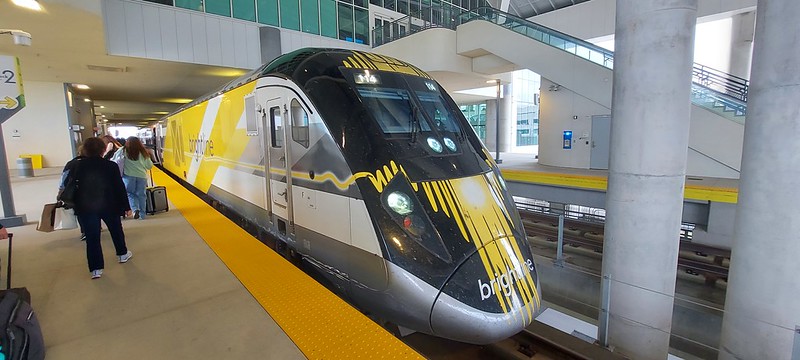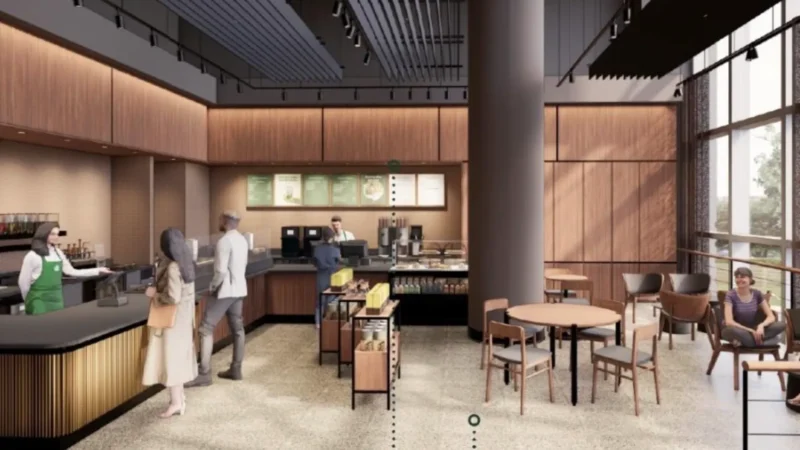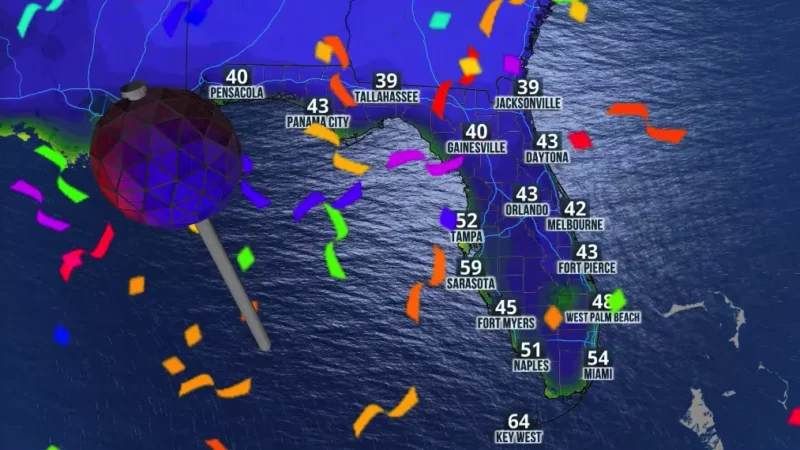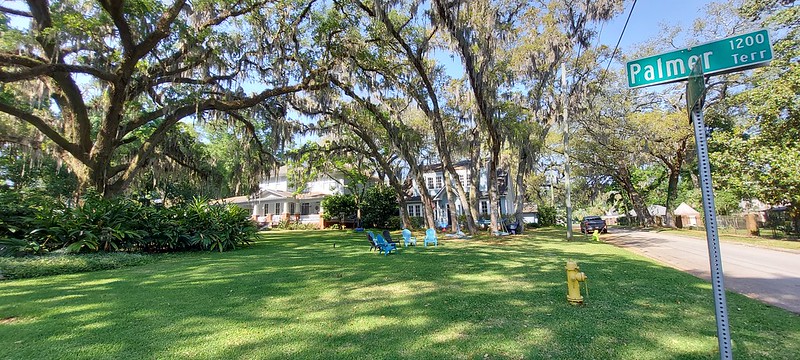
Operating between Miami and Orlando with a goal of potentially expanding to Tampa and Jacksonville, Brightline is the first privately funded intercity passenger rail system built in the U.S. in over a century.
What is Brightline?
Intercity passenger rail systems connect cities over longer distances than regional and local public transportation options like commuter rail, light rail, streetcars and city buses.
Providing fast, efficient, hospitality-driven transportation featuring the latest in customer-friendly amenities, Brightline is designed to connect cities that are too close to fly and too long to drive.
The rail system currently operates 32 trains a day — 16 in each direction — from early morning to late evening on the roughly 3.5-hour route between Orlando and Miami. Its highest speed is 125 mph.
The passenger rail system was officially launched in 2018 and initially operated between Miami and West Palm Beach. In 2023, the system was expanded to include service to Orlando International Airport. Annual ridership has increased from 579,000 in 2018 to 2,053,893 in 2023.
Brightline uses Siemens train sets with passenger coaches with ergonomic seating, Wi-Fi, and level boarding, while meeting ADA standards. Each train set holds 248 passengers. Here is a virtual tour of Florida’s new intercity passenger rail system and a brief update on future expansion plans throughout Florida.




Existing Stations
Brightline currently operates passenger rail stations located in the cities of Miami, Fort Lauderdale, Aventura, Boca Raton, West Palm Beach and Orlando.
Orlando

The Orlando International Airport Intermodal Terminal was completed in 2017. Plans for the facility predate Brightline. The terminal was originally conceived as the northern terminus of a proposed Florida High Speed Rail system that would have connected Tampa and Orlando. That plan died when then-Gov. Rick Scott rejected federal high speed rail funding that had been awarded by the Obama administration.
Connected to the airport’s recently completed Terminal C, the massive 1.3 million-square-foot intermodal terminal is designed to accommodate the airport’s Terminal Link automated people mover system and up to three additional passenger rail systems. Brightline revenue service began operating at the terminal on September 22, 2023. It is anticipated that the SunRail commuter rail system will eventually be expanded to the $684 million terminal.






West Palm Beach

Located Downtown, the West Palm Beach Brightline station began revenue service on January 13, 2018. The 60,000-square-foot station and platform occupies a two-acre site near the intersection of Clematis Street and Quadrille Boulevard. It is located within walking distance of 10,000 residents, 30,000 workers and most of the city’s vibrant, pedestrian-friendly streets.
In 2018, Florida East Coast Industries, in partnership with Lincoln Property Co., developed a 24-story, 290-unit apartment tower and transit-oriented development adjacent to the station. In 2020, FECI sold the Park-Line Palm Beaches apartment tower to New York Life for $114.8 million.





Boca Raton

One of Brightline’s newest stations, the Boca Raton station began revenue service on December 21, 2022. Home to 99,009 residents at the time, Boca Raton was the second-largest city in Palm Beach County. Located adjacent to the city’s main public library, the 22,000-square-foot station also includes a 455-space parking garage. The 1.8-acre property was built at a cost of $56 million. In 2020, the city of Boca Raton was awarded a $16.35 million Consolidated Rail Infrastructure and Safety Improvement grant for the project from the U.S. Department of Transportation. The station project resulted in the creation of 500 construction jobs and 40 permanent jobs.
Fort Lauderdale

The Fort Lauderdale station began revenue service in January 2018. Occupying a 4-acre site, the 60,000-square-foot station and 800-foot-long train platform was constructed adjacent to Broward County’s Central Terminal downtown. The Brightline station property also includes a parking garage and car rental services.
In early 2023, Fort Lauderdale-based OceanLand paid $13.2 million for a vacant 1-acre lot next to the station. OceanLand plans to construct a 392-unit residential building with ground-floor retail steps from the station. OceanLand’s project is one of several transit oriented developments that are planned or have sprouted up within walking distance of Fort Lauderdale’s train station since 2018.



Aventura

Aventura Mall is the largest mall in Florida. The suburban South Florida shopping destination is also home to a new Brightline station. A 15-minute train ride from either Downtown Miami or Fort Lauderdale, the $76 million station began revenue service on December 24, 2022. Built on a 3-acre site, the 34,000-square-foot station includes 240 parking spaces and complimentary shuttle service to and from the mall. In the future, a bridge will be constructed over an adjacent highway to directly connect the train station to the shopping mall.
Miami

Railroad tycoon Henry Flagler opened Miami’s first passenger railroad station in 1896. This downtown station was replaced in 1912 by a structure that served the city for more than 50 years. In 1963, Miami’s historic passenger railroad station was demolished. The crown jewel of the Brightline system, Downtown Miami’s MiamiCentral Station is located on the site of the city’s long-demolished station. Spanning six blocks and 9 acres, the 3 million-square-foot mixed-use terminal includes office and residential towers with 1,080 units, a retail concourse and a 26,000-square-foot, 16-stall food hall. Revenue service began at MiamiCentral on May 19, 2018. The station is also connected with other forms of public transit, including Metrorail, Metromover, Metrobus, city of Miami trolley, and Tri-Rail commuter rail systems. Tri-Rail began operations at MiamiCentral on January 13, 2024.








Proposed stations and future expansion

Now operating service between Miami and Orlando, the company has proposed extending the Brightline rail system to Tampa. The proposed route would largely be constructed in the middle of Interstate 4. It would include at least one station located along Interstate 4 near Disney Springs and State Road 536/World Center Drive. Lakeland and Polk County officials have also expressed interest in having a station as well.
In March 2024, Tampa Mayor Jane Castor mentioned that she was hopeful that passengers would be traveling between Orlando and Tampa in four to five years. While Brightline has not officially acquired real estate in the area, Tampa’s proposed station is planned to be located in or near Ybor City. In the meantime, additional stations were recently proposed for Stuart and Cocoa along Florida’s East Coast.

On March 4, Brightline announced plans to develop a new infill station in Downtown Stuart. The decision to select Stuart was driven by a number of factors, including the location and the ease with which the site will integrate into Brightline’s existing rail infrastructure network. The $60 million station is proposed for a 2.35 acre site. Revenue service is anticipated to begin by the end of 2026.
On March 12, 2024, Brightline announced its intent to also add an infill station in Cocoa. The Cocoa station would be built at what’s known as “the Cocoa curve” near where State Road 528 crosses the Florida East Coast Railway and U.S. 1. The construction timeline and total project cost have not been determined.
What about Jacksonville?

In 2016, Brightline secured rights to run passenger rail service on the Florida East Coast Railway line between Cocoa and Jacksonville. Such a service could include intercity passenger rail stations in Downtown Jacksonville, St. Augustine and Daytona Beach. While Jacksonville has been on Brightline’s radar for years, no firm commitment has been obtained to expand the system to town.
As we reported in a recent Jaxson editorial by Marcus Nelson, the U.S. Department of Transportation’s Federal Railroad Administration was awarded $8.2 billion in December 2023 to construct 10 passenger rail projects across the country and more for corridor planning activities nationwide. Among these was an award to the Florida Department of Transportation of a Corridor Identification & Development grant to begin studying a passenger rail corridor between Jacksonville, Orlando and Miami.
According to the federal administration, “The proposed corridor…would provide new or enhanced service on one or more existing alignments, including the FEC Railroad corridor that Brightline previously secured rights to operate on.” Up to $500,000 was allocated for this rail planning effort.
An additional $500,000 was allocated to develop a scope, schedule, and cost estimate for preparing, completing, or documenting the service development plan for the corridor between the three cities. Jacksonville’s participation in this corridor planning process represents an opportunity to bring enhanced intercity passenger rail services like Brightline to Northeast Florida.








